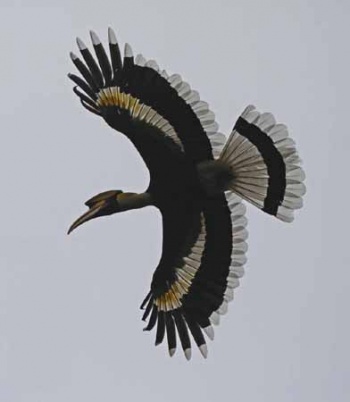Alternative names: Great Pied Hornbill; Giant Hornbill; Concave-casqued Hornbill; Great Indian Hornbill
- Buceros bicornis
Identification
122cm (48 inches)
Pale yellow bill, casque and neck contrasting with black mask and body plumage diagnostic. Broad white bars on trailing edge and centre of wing.
Tail white with black subterminal band.
Male: Front of of casque black and iris red.
Female: iris White.
Under wing flight pattern,black wings with white bar and trailing edge together with white tail and black subterminal tail distinctive.
Juveniles have blue-grey eyes and a small casqueless bill which needs 5 years to fully grow.
Distribution
Found in the Western Ghats in southwest India and in the foothills of the Himalaya from India to Nepal and Bhutan east to Burma, southern China (western Yunnan), Thailand, Laos, Vietnam, Cambodia, the Malay Peninsula and on Sumatra.
The population is declining, especially outside national parks. Rare in southwest India and Sumatra.
Taxonomy
This is a monotypic species.
Forms a superspecies with Rhinoceros Hornbill and hybrids have been reported from the wild and in captivity.
Habitat
Primary evergreen forests.
Occurs up to 2000m.
Behaviour
Found singly or in pairs or sometimes in large loose groups in the canopy.
Diet
Feeding in fruiting trees together with other hornbills. In the wild it has been observed associating with Rhinoceros Hornbill. Sound of wings like Rhinoceros Hornbill.
Breeding
Breeding season from January to April. A monogamous and territorial species. The nest is placed in a natural tree hole 8 - 35m above the ground. The entrance is sealed by both sexes, the female stays in the nest and is being fed by the male. Lays 2 eggs. The female emerges from the nest after several weeks (up to 4 months).
References
- Del Hoyo, J, A Elliot, and J Sargatal, eds. 2001. Handbook of the Birds of the World. Volume 6: Mousebirds to Hornbills. Barcelona: Lynx Edicions. ISBN 978-8487334306
- Clements, J. F., T. S. Schulenberg, M. J. Iliff, D. Roberson, T. A. Fredericks, B. L. Sullivan, and C. L. Wood. 2018. The eBird/Clements checklist of birds of the world: v2018. Downloaded from http://www.birds.cornell.edu/clementschecklist/download/
Recommended Citation
- BirdForum Opus contributors. (2025) Great Hornbill. In: BirdForum, the forum for wild birds and birding. Retrieved 26 April 2025 from https://www.birdforum.net/opus/Great_Hornbill
External Links
GSearch checked for 2020 platform.1






